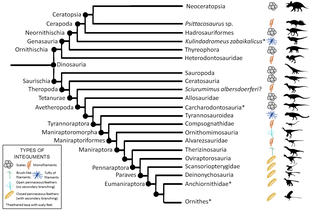| Avifilopluma Temporal range:
Middle Jurassic–Recent,
| |
|---|---|

| |
| Illustration showing various types of feathers | |
|
Scientific classification
| |
| Domain: | Eukaryota |
| Kingdom: | Animalia |
| Phylum: | Chordata |
| Clade: | Avemetatarsalia |
| Clade: |
Avifilopluma Gauthier & de Queiroz, 2001 |
| Subgroups | |
|
Also see text. | |
| Synonyms | |
| |
Avifilopluma ("bird filoplumes") is a clade containing all animals with feathers. Unlike most clades, which are defined based on relative relationships, Avifilopluma is defined based on an apomorphy, that is, a unique physical characteristic shared by one group and not found outside that group (in this case, feathers). Its content is unclear, and has been speculated to range from Coelurosauria to all of Ornithodira.
Definition
The clade Avifilopluma was created along with several other apomorphy-based clades relating to birds by Jacques Gauthier and Kevin de Queiroz in a 2001 paper. Their specific definition for the group was "the clade stemming from the first pan-avian with feathers homologous (synapomorphic) with those of Aves (Vultur gryphus Linnaeus 1758)." [1]
The authors went on to define specifically what qualified as a "feather": Any filamentous structure arising from a follicle in the skin, with a hollow base, that shares common ancestry with the feathers of modern birds. [1]
Content
Gauthier and de Queiroz originally referred a number of prehistoric species to this group, on the basis of fossilized feather traces. These included what they considered to be non-avian dinosaurs such as Sinornithosaurus, Archaeopteryx, and the enantiornithines, all of which had true feathers. They tentatively considered the simpler feathers of other dinosaurs like Sinosauropteryx and Beipiaosaurus to be homologues of modern feathers and thus probably included in Avifilopluma. Therefore, they concluded that Avifilopluma would include most of the clade Maniraptora or Coelurosauria. [1]
The authors went further, and speculated that pending more complete knowledge of dinosaur skin structures, even the most primitive theropods could turn out to be avifiloplumans. [1] This idea gained tentative support with the discovery of Tianyulong, an ornithischian dinosaur with apparently hollow, filamentous feather-like fibers covering its body. This specimen was described by Zheng and colleagues in 2009, who noted definite similarities between the filaments of Tianyulong and coelurosaurian theropods, supporting the idea that all such structures were homologous with modern feathers, and pushing the origin of feathers back to the origin of dinosaurs or earlier. [2] The discovery of Kulindadromeus supported the idea that feathers were already present in the last common ancestor of ornithischians and theropods, which was either the first dinosaur or the first ornithoscelidan depending on how ornithischians are related to other dinosaurs. [3] [4]
Some scientists have gone even further and suggested that the downy filaments present in pterosaurs are also feathers, and if this is the case, it would place the origin of feathers at or before the primitive split between dinosaurs and pterosaurs ( Ornithodira). [5] [6]

See also
References
- ^ a b c d Gauthier, J. and de Queiroz, K. (2001). "Feathered dinosaurs,flying dinosaurs, crown dinosaurs,and the name "Aves"". Pp. 7-41 in Gauthier, J. and L.F. Gall (eds.), New Perspectives on the Origin and Early Evolution of Birds: Proceedings of the International Symposium in Honor of John H. Ostrom. New Haven: Peabody Museum of Natural History, Yale University. ISBN 0-912532-57-2.
- ^ Zheng, Xiao-Ting; You, Hai-Lu; Xu, Xing; Dong, Zhi-Ming (19 March 2009). "An Early Cretaceous heterodontosaurid dinosaur with filamentous integumentary structures". Nature. 458 (7236): 333–336. Bibcode: 2009Natur.458..333Z. doi: 10.1038/nature07856. PMID 19295609. S2CID 4423110.
- ^ Godefroit, Pascal; Sinitsa, Sofia M.; Dhouailly, Danielle; Bolotsky, Yuri L.; Sizov, Alexander V.; McNamara, Maria E.; Benton, Michael J.; Spagna, Paul (2014-07-25). "Dinosaur evolution. A Jurassic ornithischian dinosaur from Siberia with both feathers and scales". Science. 345 (6195): 451–455. doi: 10.1126/science.1253351. hdl: 1983/a7ae6dfb-55bf-4ca4-bd8b-a5ea5f323103. ISSN 1095-9203. PMID 25061209. S2CID 206556907.
- ^ Andrea, C. A. U. (2018). The assembly of the avian body plan: a 160-million-year long process. Bollettino della Società Paleontologica Italiana, 57(1), 2.
- ^ Czerkas, S.A., and Ji, Q. (2002). A new rhamphorhynchoid with a headcrest and complex integumentary structures. In: Czerkas, S.J. (Ed.). Feathered Dinosaurs and the Origin of Flight. The Dinosaur Museum:Blanding, Utah, 15-41. ISBN 1-932075-01-1.
- ^ Yang, Zixiao; Jiang, Baoyu; McNamara, Maria E.; Kearns, Stuart L.; Pittman, Michael; Kaye, Thomas G.; Orr, Patrick J.; Xu, Xing; Benton, Michael J. (January 2019). "Pterosaur integumentary structures with complex feather-like branching". Nature Ecology & Evolution. 3 (1): 24–30. doi: 10.1038/s41559-018-0728-7. hdl: 1983/1f7893a1-924d-4cb3-a4bf-c4b1592356e9. ISSN 2397-334X. PMID 30568282. S2CID 56480710.
- ^ Benton, Michael J.; Dhouailly, Danielle; Jiang, Baoyu; McNamara, Maria (2019-09-01). "The Early Origin of Feathers". Trends in Ecology & Evolution. 34 (9): 856–869. doi: 10.1016/j.tree.2019.04.018. hdl: 10468/8068. ISSN 0169-5347. PMID 31164250. S2CID 174811556.